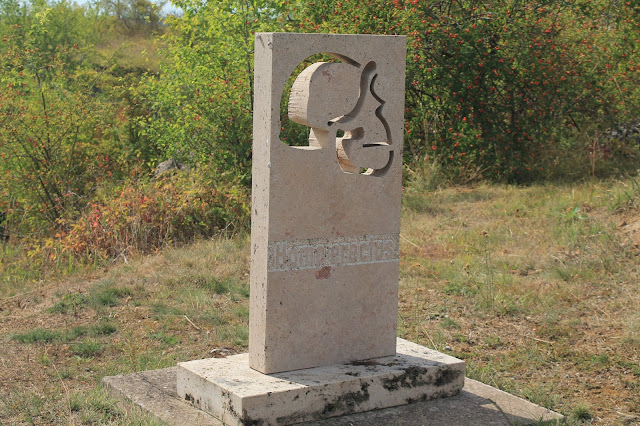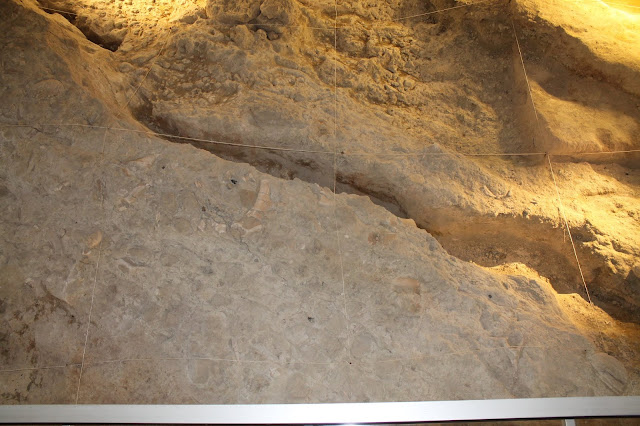Germany: Fossils
Some of Germany's Best Fossils
See dinosaurs, flying archaeopteryx, echinoderms, and even homo erectus!
What's Here: This trip is a quick look at some of Germany's best places to see fossils. It's not a comprehensive photo journal (that would be impossible!), just enough to wet your appetite. All of these sites are off the normal tourist routes, and are not crowded.
The sites are:
University of Tubingen
Urwelt Museum Hauff near Holzmaden
Bergmeister Muller Museum in Solnhofen
Steinrinne Bilzingsleben Homo Erectus site
U. Tubingen Paleontological Museum
Tubingen is in SE Germany, not far south of Stuttgart. It's a wonderful Medieval university town to visit, and the university has this amazing paleontological museum. Admission is free. Their Website only shows a tiny percentage of the collection. Location: 48.526043, 9.059837Stahleckeria was a thick, squat dicynodont that lived in the Triassic of Brazil and Namibia (which were attached) about 240 million years ago. It was about 4 meters long and weighed just short of 400 kg. -- not bad for a vegetarian! This specimen was collected in Brazil in about 1935. In person, it's mighty imposing!
One of the most striking specimens in the museum is this keratocephalus moloch, a thick-headed therapsid. It's not difficult to picture that thick skull covered with rough skin. It was about 3 meters long and over 400 kg, and also a vegetarian. It lived in South Africa about 280 million years ago (Permian).
"You're pulling my leg" isn't an expression Dinosaurs used much -- too big a job!
I'm glad these big swimming reptiles are extinct! The museum has many specimens of similar species, the best know of which is the ichthyosaur. I think these are cryptoclidus.
This wing of the museum was built specifically to house this incredible specimen (described below). It was the world's largest crinoid (a sea lilly) for many decades until a bigger one was found and put on display in Holzmaden (see below).
A closer view from the side shows the incredible detail preserved in mud.
Crinoid stems are made of disk-shaped segments, or columnals. Crinoid columnals are abundant around the world in shallow marine limestones, but are rarely intact as these are.
Stenosaurus, another swimming reptile that I'd hate to meet!
City of Tubingen
Another appeal of Tubingen is its beautiful old town. This is the Gothic St. George's Collegiate Church, which dates back to 1470. It was notably one of the early churches converted to follow Luther. Website.You'll enjoy every meter of old town Tubingen!
Germans have the right word for the town hall -- "Rathaus!" This ornate structure was built in 1435, and added onto and reconstructed over the centuries.
An overlook of Tubingen from the castle on the hill.
The castle houses several museums that are worth traveling to Tubingen to see.
DNA was discovered in the lab in this wing!
Amazing astronomer Johannes Kepler was a student at U. of Tubingen, and studied in this hall. According to NASA, among his discoveries and "firsts" were:
- First to investigate the formation of pictures with a pin hole camera;
- First to explain the process of vision by refraction within the eye;
- First to formulate eyeglass designing for nearsightedness and farsightedness;
- First to explain the use of both eyes for depth perception.
In his book Dioptrice (a term coined by Kepler and still used today) he was the:
- First to describe: real, virtual, upright and inverted images and magnification;
- First to explain the principles of how a telescope works;
- First to discover and describe the properties of total internal reflection.
- His book Stereometrica Doliorum formed the basis of integral calculus.
- First to explain that the tides are caused by the Moon (Galileo reproved him for this).
- Tried to use stellar parallax caused by the Earth's orbit to measure the distance to the stars; the same principle as depth perception. Today this branch of research is called astrometry.
- First to suggest that the Sun rotates about its axis in Astronomia Nova
- First to derive the birth year of Christ, that is now universally accepted.
- First to derive logarithms purely based on mathematics, independent of Napier's tables published in 1614.
- He coined the word "satellite" in his pamphlet Narratio de Observatis a se quatuor Iovis sattelitibus erronibus
The bridge over the Neckar River on Eberhardsbrucke.
A view from the bridge. Tubingen is a wonderful place to spend a few days!
Beautiful Tubingen!
Urwelt Museum Hauff, Holzmaden
The Urwelt Museum Hauff houses some extraordinary displays of ancient sea life. Its website doesn't do its collection justice! Holzmaden is not far southeast of Stuttgart. Location: 48.635264, 9.528244They've arranged slabs from a fossil quarry in order from top to bottom. You can see the development of the various animals over time, and as local conditions changed. This is the best way to explain stratigraphy that I've ever seen in a museum, and is especially valuable for youth and children.
That big ammonite lived on the shallow seafloor, died, was buried, smashed flat, and turned to rock. Look for the others in the slabs.
Here's the world's largest crinoid fossil. It's over 12 meters long!
The crinoid details are astonishingly well preserved!
The exit sign. We had waaaay too much fun with signs in Germany!
Bergmeister Muller Museum, Solnhofen
Solnhofen is the famous location of a lithograph limestone quarry that also happens to contain important fossils like the primitive bird, archaeopteryx that almost everyone on Earth has seen. Since the first specimen was discovered in 1861, only eleven have ever been found! Website. Location is between Nuremberg and Munich : 48.891952, 10.992208
Rhabdocidaris orbignyana, an echinoid (close relative to a sea urchin) is so well-preserved in detail, I am truly amazed! Its protruding "legs" remind me of spinning fireworks (see how sophisticated my mind is?).
This amazing holographic display shows what archaeopteryx looked and moved like. It was installed by a company from Wyoming, and is amazing.
Here's one of the raven-sized archaeopterix fossils, complete with imprints of feathers. It's not the oldest known bird, but is close, and was the first discovered. It really changed how we think about birds and dinosaurs.
Upstairs in the museum is a fascinating demonstration of lithography. This is a lithograph press that docents demonstrate.
Did you realize that lithographic prints are literally engraved on rock? The limestone at Solnhofen, the same one with the fossils, is perfectly flat and smooth, and just soft enough to allow engraving but durable enough to make many copies. What a great use for rock!
Visitors can dig around in the limestone quarry on the hill behind the museum. It's not hard to find some fossils, mostly ammonites.
Looking down from the public quarry is the "real" one where limestone for lithography and the fossils are quarried.
Steinrinne Bilzingsleben - Homo Erectus Site
Here's a fascinating, world-class location that is rarely visited! It's located just north of Weimar in central Germany, at ancient migratory animal crossroads. Website. Location: 51.272905, 11.059128
Homo Erectus is one of our relatives, though distinctly different from modern humans in several important ways. You wouldn't mistake homo erectus for one of your neighbors -- the thick brow ridge and sloped forehead would look very, very strange on the streets today! They made stone tools, though not as advanced as later beings. They lived in Africa, Asia, and Europe between about 2 million and possibly 100,000 years ago.
Here's a small sample of bones and artifacts being studied at the site.
The head archaeologist even let us handle some of the tools! You won't find that at many archaeological sites!
Inside the covered building are preserved plants, animal bones, and homo erectus bones & artifacts. The fossils include over a dozen tree and bush species, and an impressive array of big game -- elephants, rhinoceros, deer, giant deer, bison, horse, bear, lion, fox, boar, and wolf.
A distinguished geology professor once told me I should end every presentation with a pretty picture. This is Bilzingsleben, viewed from the Homo Erectus site.
Related Trips:
Germany's Romantic Middle Rhine River
5 Awesome Places in Germany
Aletsch Glacier, Switzerland
Matterhorn, Switzerland
Glarus Thrust Fault, Switzerland
Lauterbrunnen Valley, Switzerland














































